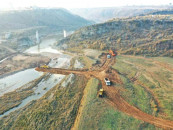Govt plans one billion mangroves along coast
Country’s coast has become increasingly vulnerable to sea-level rise

Having planted over a billion trees in the hilly regions of the country, the government is now planning to plant over a billion mangroves along its 1,000 kilometre-long coastline to boost coastal areas. This was disclosed on Friday by the Special Assistant to Prime Minister Climate Change Malik Amin Aslam. “An elaborate plan has been finalised in consultation with various national and international stakeholders to enhance mangroves forest cover in Balochistan and Sindh, where coastal areas and coastal communities are facing growing risks of climate change-caused risks, particularly cyclones, coastal erosion, sea-level rise and consequent intrusion of inland areas,” the PM’s aide on climate change said while briefing the media on Friday. “However, an ambitious plan has been sketched out under which one billion mangrove trees would be planted in the coastal areas of both provinces,” he announced, adding that the mangrove plantation is part of Prime Minister Imran Khan’s Ten Billion Tree Tsunami Programme (TBTTP). Aslam said that the massive mangrove plantation drive will help tackle existing challenges that affect man-made infrastructure and coastal ecosystems such as shoreline erosion, coastal flooding and water pollution, some of which have already become serious concerns and challenges. Climate change, Aslam stressed, poses grave risks to the coastal areas of the country along its 1,300-km-long coastal strip covering Sindh and Balochistan, which are already stressed by human activity, pollution, invasive species, and storms. Sea level rise could erode and inundate coastal ecosystems and eliminate wetlands. Further, warmer and more acidic oceans are likely to disrupt coastal and marine ecosystems. Aslam said the country’s coast has become increasingly vulnerable to sea-level rise, changes in the frequency and intensity of storms, increases in precipitation patterns and warmer ocean temperatures,” he said



















COMMENTS
Comments are moderated and generally will be posted if they are on-topic and not abusive.
For more information, please see our Comments FAQ